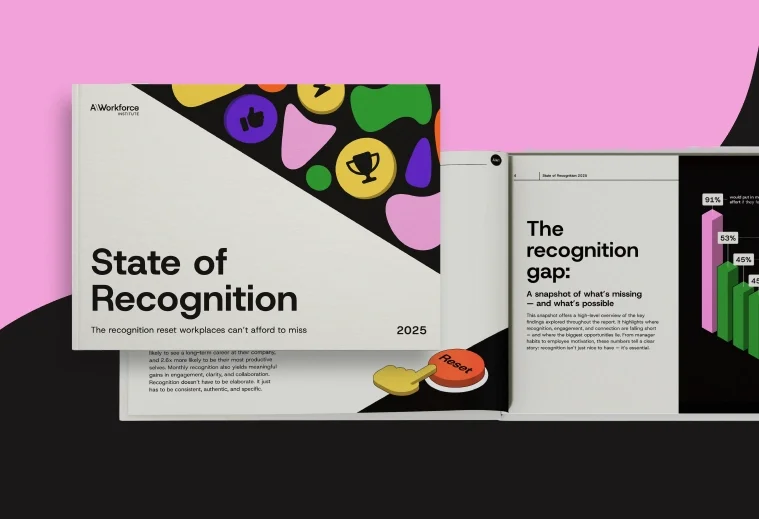Table of contents
Create a culture that means business™
Schedule a demo with an Achievers solution expert today.
A great employee recognition program does more than reward — it transforms. It turns “just a job” into a place where people actually want to show up and do their best work. And here’s the kicker: employees recognized weekly are 2.6x more likely to be their most productive selves, according to the 2025 State of Employee Recognition Report. That’s proof that recognition isn’t just about feeling good — it’s about fueling performance.
So, how do you build a program that people actually want to use — one that sparks motivation and delivers impact? We’ve got you covered. Let’s break it down together.
What is an employee recognition program?
An employee recognition program is a simple way for companies to celebrate and reward the contributions of their people — both the big wins and the everyday efforts that keep the business moving. It gives organizations a reliable way to call out great work, highlight company values in action, and keep people motivated. A strong recognition program covers every angle, from top-down and peer recognition to flexible rewards that fit every budget.
Why is employee recognition important?
Recognition programs are a must-have for any business that wants employees to stay engaged, productive, and committed. They create consistent opportunities for people to feel seen and valued for their contributions, and motivated to repeat the behaviors that keep your culture strong — and your bottom line stronger.
Who is an employee recognition program for?
Employee recognition programs are for everyone — not just high performers or top executives. When recognition is consistent and inclusive, it reaches every level of the organization: frontline, hybrid, remote, and global teams.
Where should a recognition program live?
A recognition program should live wherever your employees do their work. That means it can’t be tucked away in a portal people rarely open — it needs to show up in the flow of work, inside tools like Slack, Teams, or Outlook, and across the platforms your people use every day. But don’t stop there. Your program should also live in your workplace culture, woven into team meetings and town halls. Because when appreciation is visible in the moments that matter, it feels natural, meaningful, and impossible to ignore.
When does an employee recognition program have the most impact?
Recognition programs deliver the greatest impact when they’re woven into the everyday flow of work. When recognition is weekly, our research shows employees are 2.6x more likely to be productive and 9x more likely to feel a strong sense of belonging. Catch people in the moment, and recognition feels powerful. Wait too long, and it starts to sound more like a footnote than genuine appreciation.
How to build an employee recognition program
If you’re thinking of building an employee recognition program, you need to figure out the kind of company culture you want to cultivate and what you want your employees to take away from it. After all, recognition programs don’t become meaningful overnight. It takes thought, structure, and some trial and error.
But don’t worry, our step-by-step guide can help you get it right from the start:
1. Design the program
Designing your recognition program is like crafting a custom recipe. You want it to be adaptable so you can tweak things as you go and find what really resonates with your team. The end goal? To create something so easy to use, it slips effortlessly into your employees’ daily routines.
Set objectives
Every effective recognition program starts with a clear purpose. Are you trying to drive up engagement? Retain top talent? Encourage behaviors that reflect your company’s values? These goals should shape how you structure and measure your program. Set key performance indicators (KPIs) like participation rates or recognition frequency to keep things on track — and don’t be afraid to link recognition to broader business outcomes. The clearer your goals, the easier it is to calculate ROI.
Align with the culture
Your culture is the blueprint — the foundation that shapes how recognition should work. A great recognition program doesn’t try to change who you are; it amplifies what already makes your workplace unique. Whether your vibe is high-energy and fun or mission-driven and focused, make sure your recognition program reflects that. Recognition means more when it reflects what your company stands for, like your core values. Tying it to those values helps reinforce the culture you’re working to build, alongside the people you’re celebrating.
Allocate budget
A recognition program without a budget is like a car without gas — all potential, no movement. Whether you’re investing in software, rewards, or communications, be thoughtful about how much you’re willing to spend and where it’ll go. If you want your program to last, don’t blow the budget on bells and whistles. Think about value and sustainability, not just making a splash on day one.
Outline policies
Think of policies as the user manual for your recognition program. They don’t need to be rigid, but they do need to be clear. Define what gets recognized, who can send recognition, and how rewards work. This helps level the playing field and sets expectations across the board. Bonus points for sharing examples of what great recognition looks like.
Determine global scale
Recognition should never feel exclusive. If you have a global workforce, you need a platform that can support everyone — no matter their location, language, or time zone. Global recognition isn’t a luxury anymore. It’s a must. Choose a platform that delivers a consistent, inclusive experience whether someone’s in London, Lima, or logging in from home.
2. Introduce the new program
A successful launch takes more than an email blast. It needs intention, clarity, and momentum. Build excitement with a thoughtful rollout plan. Educate your employees. Get leadership involved. Make it crystal clear why recognition matters and how to make it part of the everyday.
And don’t forget the data. When managers understand the metrics — like recognitions sent, monthly active users, or team participation — they can lead by example and make recognition feel meaningful, not mandatory.
Some KPIs worth tracking include:
- Recognitions sent and received
- Monthly active users
- Activation rates
- Recognition index (how often people are recognizing and being recognized)
- Leadership participation
- Improvements in engagement scores over time
3. Measure the results
You’ve built it, launched it, and your team is using it — now what? It’s time to measure what’s working and what needs adjustments.
Recognition is powerful, but to prove its value, you’ll need real numbers. Track changes in retention, engagement, and even customer satisfaction. Compare pre- and post-launch data to uncover trends — and use feedback to make ongoing improvements. Employee surveys and focus groups can surface quick wins or longer-term gaps, so you’re always moving forward. When people feel heard at work, they’re more likely to stay engaged. So, ask, listen, and adapt. That’s how good programs become great.
Bonus: Finding the right recognition platform
A recognition program is only as strong as the platform behind it. The best platforms integrate seamlessly into employees’ daily tools, making it easy to recognize peers without slowing down the workday. Look for one that checks all the boxes: user-friendly, scalable, insightful, and backed by a stellar support team.
Because let’s face it — things change. New goals, growing teams, different workflows. A great platform will evolve with you and keep your recognition efforts going, no matter what the future throws your way.
Best practices for employee recognition programs
If you’re wondering whether your recognition program is hitting the mark, here are a few tried-and-true practices to keep things on track and impactful:

- Recognize employees in real time: Recognition loses its magic if it’s delayed. The more immediate the praise, the more powerful it feels. Whether it’s a spontaneous shout-out or a well-timed reward, real-time recognition reinforces great behavior the moment it happens, making it feel more genuine and memorable.
- Encourage participation through campaigns: Let’s be honest: no one gets excited about stale, repetitive recognition. Keep things fresh with creative campaigns that bring energy and excitement. Align them with holidays or company milestones. Make recognition feel like a celebration, not an obligation.
- Make recognition frequent and impactful: The more regularly recognition happens, the more ingrained it becomes in your culture. In fact, making employees feel like their contributions consistently matter can lead to big boosts in engagement, morale, and retention. If you can move employees from feeling okay about their place in the company to feeling like they belong, you could boost engagement and productivity by 400%.
- Tie recognition to specific behaviors: The most effective recognition is the kind that’s thoughtful and specific. Instead of a vague “great job,” call out what exactly someone did — and why it mattered. It not only feels more personal, but it also helps reinforce the kinds of behaviors you want to see more of.
Types of employee recognition
Recognition isn’t one-size-fits-all — and that’s a good thing. The most effective programs mix it up, using different approaches to connect with people in ways that actually resonate. Here are the three pillars every recognition strategy needs to stand tall:
Social recognition
A well-timed “thank you” can do more than boost someone’s mood — it can reinforce the behaviors you want to see more of. Whether it’s a peer shout-out or a company-wide nod, public recognition builds a culture where appreciation is visible, shareable, and contagious (in a good way).
Monetary recognition
Sometimes, a thank-you needs backup. Points, gift cards, or rewards from the global marketplace give recognition staying power. The key is flexibility — scaling rewards to match the moment, and letting employees choose what feels meaningful to them.
Peer-to-peer recognition
Let’s be honest — appreciation hits differently when it comes from someone who’s in the trenches with you. Peer recognition breaks down silos and builds real connection. When recognition comes from a teammate, it carries extra weight. Employees who are recognized at least monthly by their peers are 2x more likely to feel a strong sense of belonging and trust.
The business case for an employee recognition program
Let’s talk numbers. Because while recognition taps into emotion and human connection, the business case behind it is undeniable. Here’s the business case for building an employee recognition program:
Enhance business results
Recognition is more than a nice gesture. It has a direct impact on business performance. When employees feel valued, they’re more motivated to contribute to the company’s success. Employee recognition statistics make it clear: recognition is directly tied to business performance. Here’s what the research shows:
- Increasing recognition from quarterly to monthly boosts the likelihood of engagement and productivity by 40% and job commitment by 25%.
- Employees who are recognized monthly are 36% more likely to say they are productive and engaged, and 22% more likely to be highly committed to their roles.
Improve organizational culture
Culture is the glue that holds everything together. When employees feel connected to their work, their peers, and their leadership, they’re motivated to produce their best. According to Deloitte’s insights, there are clear incentives for leaders to prioritize culture:
- On average, employees who regularly receive recognition are 56% less likely to seek other job opportunities.
- Improving employee retention can save businesses with 10,000 employees up to $16.1 million annually.
Get executive buy-in
Even the best recognition program won’t go far without executive buy-in. To get leaders on board, show them it’s more than an HR initiative. It’s a powerful tool for driving business results.
Research from the Achievers Workforce Institute (AWI) found:
- 60% of HR leaders with an online recognition program say it’s driving business results, compared to 30% with an offline or in-house platform.
- Programs that measure specific outcomes like employee well-being, belonging, and engagement are 68% more likely to drive business results.
Create a lasting impact with an employee recognition program
Building a recognition program isn’t a quick fix — it’s a thoughtful process that takes planning, creativity, and a focus on what really matters to your people. The goal? A program that fits seamlessly into daily work, sparks real excitement, and drives measurable impact.
At Achievers, we help you bring that vision to life. Our award-winning platform combines recognition, rewards, and insights — all in one intuitive, integrated experience that works wherever your people do.
Ready to create an employee recognition program that makes a lasting impact? Let’s make that vision a reality, together.




